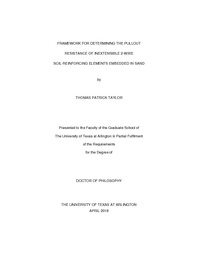
ATTENTION: The works hosted here are being migrated to a new repository that will consolidate resources, improve discoverability, and better show UTA's research impact on the global community. We will update authors as the migration progresses. Please see MavMatrix for more information.
Show simple item record
| dc.contributor.advisor | Puppala, Anand | |
| dc.creator | Taylor, Thomas Patrick | |
| dc.date.accessioned | 2018-10-23T20:17:17Z | |
| dc.date.available | 2018-10-23T20:17:17Z | |
| dc.date.created | 2018-05 | |
| dc.date.issued | 2018-10-04 | |
| dc.date.submitted | May 2018 | |
| dc.identifier.uri | http://hdl.handle.net/10106/27543 | |
| dc.description.abstract | Mechanically Stabilized Earth (MSE) has been successfully used as a commercial retaining structure since its development in 1963 by Henry Vidal (Schlosser 1990). MSE is a ground improvement system that consists of soil-reinforcing, compacted backfill, and a facing. The initial soil-reinforcing developed for commercial use by Vidal consisted of a smooth steel strip. Since then, a diverse range of soil-reinforcing has been developed, including extensible and inextensible reinforcing. The various geometric configurations of soil-reinforcing have included wide width and narrow width elements comprising planar strips, planar grids, co-planar strips, co-planar grids, and wide sheets. General specifications categorize inextensible soil-reinforcing into metallic linear strips, metallic welded-wire mesh, and metallic bar mats, while extensible soil-reinforcing is categorized into geogrids and polymer strips. A soil-reinforcing element that consists of metallic welded wire, also known as a bar-mat, with only two longitudinal wires and a series of transverse wires is currently being utilized as soil-reinforcing in MSE systems. The 2-Wire soil-reinforcing element is a linear strip that resembles a ladder. The 2-Wire configuration of inextensible soil-reinforcing is not technically categorized or defined within the general specification. In other words this raises the question, is the 2-Wire element a linear strip, a welded-wire system, a bar-mat system, or should it be uniquely identified?
The semi-empirical equations used to determine the pullout resistance of an inextensible grid system include a pullout coefficient, also known as a bearing resistance factor. The bearing resistance factor is soil-reinforcing dependent. For inextensible grid systems, it has been empirically established that the bearing resistance factor is a function of the transverse wire size and the transverse wire spacing. The spacing of the longitudinal wire is not considered in the equation. As an illustration, a grid system of a given width, for example 1220 mm, with 300 mm spaced longitudinal wires, is assumed to act in the same manner as a grid system with 50 mm spaced longitudinal wires. The objective of this research is to develop a bearing resistance factor for commonly used 2-Wire soil-reinforcing elements. This will be accomplished by performing pullout test on 2-Wire elements utilizing a state-of-practice pullout program. | |
| dc.format.mimetype | application/pdf | |
| dc.language.iso | en_US | |
| dc.subject | Mechanically stabilize earth | |
| dc.subject | MSE | |
| dc.subject | Pullout | |
| dc.subject | 2-Wire | |
| dc.subject | Soil reinforcing | |
| dc.title | Framework for Determining the Pullout Resistance of Inextensible 2-Wire Soil-Reinforcing Elements Embedded in Sand | |
| dc.type | Thesis | |
| dc.degree.department | Civil Engineering | |
| dc.degree.department | Civil Engineering | |
| dc.degree.name | Doctor of Philosophy in Civil Engineering | |
| dc.degree.name | Doctor of Philosophy in Civil Engineering | |
| dc.date.updated | 2018-10-23T20:17:18Z | |
| thesis.degree.department | Civil Engineering | |
| thesis.degree.grantor | The University of Texas at Arlington | |
| thesis.degree.level | Doctoral | |
| thesis.degree.name | Doctor of Philosophy in Civil Engineering | |
| dc.type.material | text | |
| dc.creator.orcid | 0000-0001-7828-2894 | |
Files in this item
- Name:
- TAYLOR-DISSERTATION-2018.pdf
- Size:
- 9.242Mb
- Format:
- PDF
This item appears in the following Collection(s)
Show simple item record


